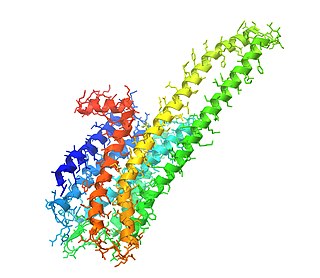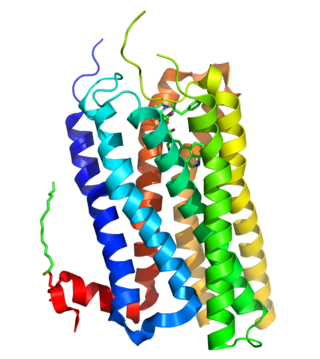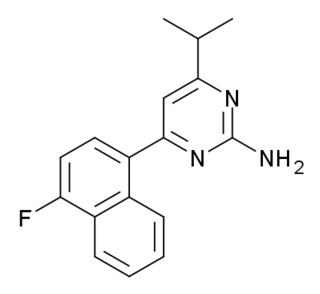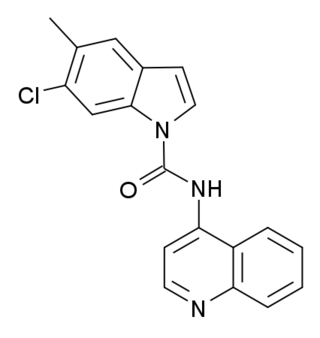
Empathogens or entactogens are a class of psychoactive drugs that induce the production of experiences of emotional communion, oneness, relatedness, emotional openness—that is, empathy or sympathy—as particularly observed and reported for experiences with 3,4-methylenedioxymethamphetamine (MDMA). This class of drug is distinguished from the classes of hallucinogen or psychedelic, and amphetamine or stimulants. Major members of this class include MDMA, MDA, MDEA, MDOH, MBDB, 5-APB, 5-MAPB, 6-APB, 6-MAPB, methylone, mephedrone, GHB, αMT, and αET, MDAI among others. Most entactogens are phenethylamines and amphetamines, although several, such as αMT and αET, are tryptamines. When referring to MDMA and its counterparts, the term MDxx is often used. Entactogens are sometimes incorrectly referred to as hallucinogens or stimulants, although many entactogens such as ecstasy exhibit psychedelic or stimulant properties as well.

5-HT receptors, 5-hydroxytryptamine receptors, or serotonin receptors, are a group of G protein-coupled receptor and ligand-gated ion channels found in the central and peripheral nervous systems. They mediate both excitatory and inhibitory neurotransmission. The serotonin receptors are activated by the neurotransmitter serotonin, which acts as their natural ligand.

The 5-HT2A receptor is a subtype of the 5-HT2 receptor that belongs to the serotonin receptor family and is a G protein-coupled receptor (GPCR). The 5-HT2A receptor is a cell surface receptor, but has several intracellular locations.

A serotonin receptor agonist is an agonist of one or more serotonin receptors. They activate serotonin receptors in a manner similar to that of serotonin, a neurotransmitter and hormone and the endogenous ligand of the serotonin receptors.

Mesulergine (INNTooltip International Nonproprietary Name) (developmental code name CU-32085) is a drug of the ergoline group which was never marketed. It acts on serotonin and dopamine receptors. Specifically, it is an agonist of dopamine D2-like receptors and serotonin 5-HT6 receptors and an antagonist of serotonin 5-HT2A, 5-HT2B, 5-HT2C, and 5-HT7 receptors.. It also has affinity for the 5-HT1A, 5-HT1B, 5-HT1D, 5-HT1F, and 5-HT5A receptors. The compound had entered clinical trials for the treatment of Parkinson's disease; however, further development was halted due to adverse histological abnormalities in rats. It was also investigated for the treatment of hyperprolactinemia (high prolactin levels).

5-Hydroxytryptamine receptor 2B (5-HT2B) also known as serotonin receptor 2B is a protein that in humans is encoded by the HTR2B gene. 5-HT2B is a member of the 5-HT2 receptor family that binds the neurotransmitter serotonin (5-hydroxytryptamine, 5-HT). Like all 5-HT2 receptors, the 5-HT2B receptor is Gq/G11-protein coupled, leading to downstream activation of phospholipase C.

Terguride, sold under the brand name Teluron, is a serotonin receptor antagonist and dopamine receptor agonist of the ergoline family. It is approved for and used as a prolactin inhibitor in the treatment of hyperprolactinemia in Japan. Terguride is taken by mouth.

Sarpogrelate is a drug which acts as an antagonist at the serotonin 5-HT2A5-HT2B, and 5-HT2C receptors. However, its affinities for the human 5-HT2C and 5-HT2B receptors are about one and two orders of magnitude lower than for the human 5-HT2A receptor, respectively. The drug blocks serotonin-induced platelet aggregation, and has potential applications in the treatment of many diseases including diabetes mellitus, Buerger's disease, Raynaud's disease, coronary artery disease, angina pectoris, and atherosclerosis.

RS-127445 is a drug which acts as a potent and selective antagonist at the serotonin 5-HT2B receptor, with around 1000 times selectivity over the closely related 5-HT2A and 5-HT2C receptors. The role of the 5-HT2B receptor in the body is still poorly understood, and RS-127445 has been a useful tool in unravelling the function of the various systems in which this receptor is expressed.

SB-204741 is a drug which acts as a potent and selective antagonist at the serotonin 5-HT2B receptor, with around 135x selectivity over the closely related 5-HT2C receptor, and even higher over the 5-HT2A receptor and other targets. It is used in scientific research for investigating the functions of the 5-HT2B receptor.

RS-102221 is a drug developed by Hoffmann–La Roche, which was one of the first compounds discovered that acts as a potent and selective antagonist at the serotonin 5-HT2C receptor, with around 100× selectivity over the closely related 5-HT2A and 5-HT2B receptors. It has anxiolytic effects in animal studies, increases the effectiveness of SSRI antidepressants, and shows a complex interaction with cocaine, increasing some effects but decreasing others, reflecting a role for the 5-HT2C receptor in regulation of the dopamine signalling system in the brain.

BW-723C86 is a tryptamine derivative drug which acts as a 5-HT2B receptor agonist. It has anxiolytic effects in animal studies, and is also used for investigating the function of the 5-HT2B receptor in a range of other tissues.

LY-272,015 is a beta-carboline derivative drug developed by Eli Lilly, which acts as a potent and selective antagonist at the serotonin 5-HT2B receptor. It has anti-hypertensive effects in animal models, and is also used in research into the other functions of the 5-HT2B receptor.

SDZ SER-082 is a drug which acts as a mixed antagonist for the 5-HT2B and 5-HT2C serotonin receptors, with good selectivity over other serotonin receptor subtypes and slight preference for 5-HT2C over 5-HT2B. It has been used in animal studies into the behavioural effects of the different 5-HT2 subtypes, and how they influence the effects of other drugs such as cocaine.

SB-215505 is a drug which acts as a potent and selective antagonist at the serotonin 5-HT2B receptor, with good selectivity over the related 5-HT2A and 5-HT2C receptors. It is used in scientific research into the function of the 5-HT2 family of receptors, especially to study the role of 5-HT2B receptors in the heart, and to distinguish 5-HT2B-mediated responses from those produced by 5-HT2A or 5-HT2C.

Serotonin antagonist and reuptake inhibitors (SARIs) are a class of drugs used mainly as antidepressants, but also as anxiolytics and hypnotics. They act by antagonizing serotonin receptors such as 5-HT2A and inhibiting the reuptake of serotonin, norepinephrine, and/or dopamine. Additionally, most also antagonize α1-adrenergic receptors. The majority of the currently marketed SARIs belong to the phenylpiperazine class of compounds.

PRX-08066 is a drug discovered and developed by Predix Pharmaceuticals [Dale S. Dhanoa et al. Patent US 7,030,240 B2], which acts as a potent and selective antagonist at the serotonin 5-HT2B receptor, with a 5-HT2Bbinding affinity (Ki) of 3.4nM, and high selectivity over the closely related 5-HT2A and 5-HT2C receptors and other receptor targets. PRX-08066 and other selective 5-HT2B antagonists are being researched for the treatment of pulmonary arterial hypertension, following the discovery that the potent 5-HT2B agonist norfenfluramine produces pulmonary arterial hypertension and subsequent heart valve damage. In animal studies, PRX-08066 has been found to reduce several key indicators of pulmonary arterial hypertension and improved cardiac output, with similar efficacy to established drugs for this condition such as bosentan, sildenafil, beraprost and iloprost. It is also being researched for potential anti-cancer applications, due to its ability to inhibit fibroblast activation.

SB-206553 is a drug which acts as a mixed antagonist for the 5-HT2B and 5-HT2C serotonin receptors. It has anxiolytic properties in animal studies and interacts with a range of other drugs. It has also been shown to act as a positive allosteric modulator of α7 nicotinic acetylcholine receptors. Modified derivatives of SB-206553 have been used to probe the structure of the 5-HT2B receptor.
5-HT2C receptor agonists are a class of drugs that activate 5-HT2C receptors. They have been investigated for the treatment of a number of conditions including obesity, psychiatric disorders, sexual dysfunction and urinary incontinence.

Amesergide is a serotonin receptor antagonist of the ergoline and lysergamide families related to methysergide which was under development by Eli Lilly and Company for the treatment of a variety of conditions including depression, anxiety, schizophrenia, male sexual dysfunction, migraine, and thrombosis but was never marketed. It reached phase II clinical trials for the treatment of depression, erectile dysfunction, and premature ejaculation prior to the discontinuation of its development.



















